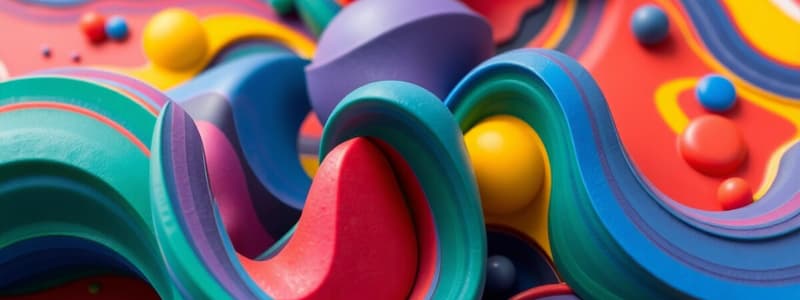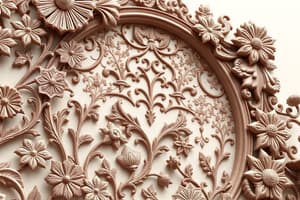Podcast
Questions and Answers
What is one purpose of support structures in additive manufacturing?
What is one purpose of support structures in additive manufacturing?
- To hold up overhanging features during printing (correct)
- To improve part aesthetics
- To reduce material costs
- To enhance machine speed
Which of the following is a common post-processing technique in additive manufacturing?
Which of the following is a common post-processing technique in additive manufacturing?
- Material deposition
- Mechanical sanding (correct)
- Digital modeling
- Layer cross-section formation
How can material properties impact the additive manufacturing process?
How can material properties impact the additive manufacturing process?
- They affect the layer thickness and build parameters (correct)
- They determine the machine's noise level
- They influence the design software used
- They control the machine's speed
What is a common application of additive manufacturing?
What is a common application of additive manufacturing?
What is one characteristic of AM machines designed for varied materials?
What is one characteristic of AM machines designed for varied materials?
Why might some parts require shrinkage or coating allowances during additive manufacturing?
Why might some parts require shrinkage or coating allowances during additive manufacturing?
What typically happens if the setup procedure for an AM machine is incorrect?
What typically happens if the setup procedure for an AM machine is incorrect?
What is one of the first stages in the additive manufacturing process?
What is one of the first stages in the additive manufacturing process?
What is the primary purpose of using support structures in photopolymer-based systems?
What is the primary purpose of using support structures in photopolymer-based systems?
How does the layer thickness in Additive Manufacturing generally affect the build process?
How does the layer thickness in Additive Manufacturing generally affect the build process?
What is the primary reason support structures are needed in some AM processes?
What is the primary reason support structures are needed in some AM processes?
What is a key consideration when post-processing parts made of different materials?
What is a key consideration when post-processing parts made of different materials?
Which method is primarily used during post-processing for finishing parts?
Which method is primarily used during post-processing for finishing parts?
Which of the following is an advantage of powder-based systems in Additive Manufacturing?
Which of the following is an advantage of powder-based systems in Additive Manufacturing?
What is a common characteristic of parts produced by AM machines?
What is a common characteristic of parts produced by AM machines?
How does the performance of AM parts typically compare to those made through conventional manufacturing?
How does the performance of AM parts typically compare to those made through conventional manufacturing?
Which factor does NOT influence the time and skill required for a stage in the AM process?
Which factor does NOT influence the time and skill required for a stage in the AM process?
Which of the following statements about support removal in AM is true?
Which of the following statements about support removal in AM is true?
What defines the thinnest wall that can be fabricated in Additive Manufacturing?
What defines the thinnest wall that can be fabricated in Additive Manufacturing?
What is a key benefit of using power tools in the post-processing stage?
What is a key benefit of using power tools in the post-processing stage?
What is a limitation of using newer photopolymer resins in AM?
What is a limitation of using newer photopolymer resins in AM?
Why are the properties of parts created by AM often described as anisotropic?
Why are the properties of parts created by AM often described as anisotropic?
What distinguishes Zcorp parts created using binder printing in a powder bed from other AM techniques?
What distinguishes Zcorp parts created using binder printing in a powder bed from other AM techniques?
Which factor is influencing the ongoing development of AM materials and processes?
Which factor is influencing the ongoing development of AM materials and processes?
What are the primary materials used in photopolymerization processes?
What are the primary materials used in photopolymerization processes?
Which radiation type is predominantly used to cure photopolymers?
Which radiation type is predominantly used to cure photopolymers?
Which discovery did Charles Hull make in the mid-1980s related to photopolymers?
Which discovery did Charles Hull make in the mid-1980s related to photopolymers?
What application of photo-curable resins is commonly found in dentistry?
What application of photo-curable resins is commonly found in dentistry?
What types of radiation are used to cure commercial photopolymers besides UV?
What types of radiation are used to cure commercial photopolymers besides UV?
What type of polymerization is primarily associated with acrylates used in photopolymers?
What type of polymerization is primarily associated with acrylates used in photopolymers?
Which type of radiation is NOT commonly used for curing commercial photopolymers?
Which type of radiation is NOT commonly used for curing commercial photopolymers?
What is the role of a photoinitiator in photopolymer systems?
What is the role of a photoinitiator in photopolymer systems?
What happens during the laser scan VAT polymerization process?
What happens during the laser scan VAT polymerization process?
Which of the following materials is typically used as a raw material in photopolymer formulation?
Which of the following materials is typically used as a raw material in photopolymer formulation?
What is formed during the interpenetrating polymer network formation in photopolymers?
What is formed during the interpenetrating polymer network formation in photopolymers?
Which subsystem is NOT a part of vector scan VP machines?
Which subsystem is NOT a part of vector scan VP machines?
After a layer has been cured in a laser scan VP process, what occurs next?
After a layer has been cured in a laser scan VP process, what occurs next?
What is the minimum unit size of hardened polymer in the atypical point-wise Microsterolithography process?
What is the minimum unit size of hardened polymer in the atypical point-wise Microsterolithography process?
Which of the following best describes a drawback of using photopolymers in additive manufacturing?
Which of the following best describes a drawback of using photopolymers in additive manufacturing?
What performance factor in laser scan vat photopolymerization technology is especially noted for accuracy?
What performance factor in laser scan vat photopolymerization technology is especially noted for accuracy?
Which benefit of mask projection VP technology is highlighted over laser scan SL?
Which benefit of mask projection VP technology is highlighted over laser scan SL?
What limits the use of stereolithography (SL) processes in many production applications?
What limits the use of stereolithography (SL) processes in many production applications?
What is the maximum size of a fabrication structure in the atypical point-wise Microsterolithography process?
What is the maximum size of a fabrication structure in the atypical point-wise Microsterolithography process?
Which aspect is a contributing factor to the surface finish of SL parts reaching over 100 µm Ra?
Which aspect is a contributing factor to the surface finish of SL parts reaching over 100 µm Ra?
Which of the following is NOT a stated advantage of vat photopolymerization technology?
Which of the following is NOT a stated advantage of vat photopolymerization technology?
Flashcards are hidden until you start studying
Study Notes
Additive Manufacturing (AM) Process Steps
- AM processes involve a series of steps, from preparation to final application.
- The process consists of eight steps.
Variations in AM Machines
- Layer thickness varies between machines, with most AM machines building layers around 0.1 mm.
- FDM Dimension machines use layer thickness of 0.254 mm.
- SL technology uses layer thickness between 0.05-0.1 mm.
- Layer thickness impacts build time: thicker layers mean faster build times but less precision.
- Fine details in a design can be challenging for some AM technologies: wall thickness, droplet size, laser diameter, and extrusion head all limit the finest details achievable.
- Variations between materials within the same process impact the time, resources, and skill required.
- Post-processing considerations depend on the material's heat resistance or melting temperature, as well as its properties for abrasive or machining-based processing.
Photopolymer-Based AM Systems
- These systems are easy to set up.
- Liquid vat systems require supports made of the same material as the part.
- Droplet deposition systems allow for modification of support material as it's printed, making them easier to remove.
- Photopolymer systems offer good accuracy with thin layers but have relatively poor mechanical properties compared to other AM materials.
- Newer resins offer improved temperature resistance, strength, and ductility, but UV protection is crucial to prevent degradation.
Powder-Based AM Systems
- No need for supports; powder is deposited layer by layer.
- Easy to set up for simple builds.
- Zcorp. parts created using binder printing in a powder bed are unique in their ability to be colored using colored binder material.
- Several preparatory steps may be required: verifying part correctness, visualizing and manipulating the part, repositioning or reorienting the part for optimal build location, building multiple parts, applying shrinkage or coating allowances, and segmenting STL files.
Machine Setup in AM
- Each AM machine has specific setup parameters.
- Simple machines may have only a few setup options, while others offer more complex configurations.
- Incorrect setup may still produce a part but result in unacceptable quality.
Build Stage in AM
- This stage is semi-automated.
- Manual control and decision-making are required during early stages.
- Once the initial steps are complete, the build process becomes computer-controlled.
- Layer-based manufacturing occurs, with a sequence of layer control, material deposition, and layer cross-section formation.
- The process repeats until the build is complete or material runs out.
Removal and Cleanup in AM
- Ideally, the part should be ready for use after the build.
- However, most parts require manual finishing.
- Parts must be separated from the build platform and excess material.
- Support structures may be needed to prevent warping or collapse during the build.
- Removal of supports often requires manual work and skill to avoid damaging the part.
- Cleanup is considered the initial part of post-processing.
Post-Processing in AM
- Manual stages of finishing parts for specific applications.
- May involve abrasive finishing (polishing, sanding), coatings, or other finishing tasks.
- Post-processing requirements vary based on the application.
- Some applications require minimal post-processing, while others demand careful handling.
- Power tools and equipment can assist various post-processing tasks.
Applying AM Parts
- Following post-processing, parts are ready for use.
- Properties may differ from traditionally manufactured parts.
- AM parts may contain voids or bubbles, leading to potential failure under stress.
- Material degradation during the build can impact bonding, linking, and crystallization.
- Properties are often anisotropic, meaning they vary based on direction.
- Despite limitations, AM materials and processes are constantly improving, and many applications do not demand high performance.
- AM applications are increasing as technology progresses.
Photopolymerization Processes
- Photopolymerization uses liquid resins that cure with radiation, primarily in the ultraviolet (UV) range.
- Photopolymers were developed in the 1960s and are widely used in coatings and printing industries.
- They are also used in dentistry for sealing teeth and preventing cavities.
- In the mid-1980s, Charles Hull experimented with UV curable materials and discovered that solid patterns could be created with a scanning laser, marking the beginning of Stereolithography (SL) technology.
- Common radiation used for curing photopolymers includes gamma rays, x-rays, UV, and visible light.
Layer-Based Built Phenomena and Errors
- The layer-by-layer construction process can cause visible "stair steps" due to the stacking of layers.
Vector Scan Micro-Vat Photopolymerization
- This process uses lasers and X-rays to create microstructures with high accuracy.
- The process can create features as small as 5µm x 5µm x 3µm.
Mask Projection VP Technologies and Processes
- Mask Projection VP technology uses a mask to project an image onto the photopolymer resin, allowing for faster curing compared to laser scanning.
Commercial MPSL System
- This system utilizes Mask Projection Stereolithography (MPSL) technology.
Two-Photon VP
- This process uses a focused laser beam to cure the photopolymer resin.
- The beam is scanned across the material to create the desired shape.
Process Benefits and Drawbacks
- Benefits:
- High accuracy and surface finish.
- Flexibility in machine configurations and size scales.
- Mask projection VP systems offer faster curing times than laser scanning systems.
- Drawbacks:
- The range of photopolymer chemistries is limited to acrylates and epoxies, which impacts material strength and durability.
- Photopolymers can degrade over time, affecting their mechanical properties.
- The limitations in material properties restrict the use of SL in many production applications.
UV Curable Photopolymers
- They are widely used as photoresists in the microelectronic industry.
- Common radiation types used include gamma rays, x-rays, electron beams, UV, and visible light, with UV and electron beam being the most prevalent.
Photopolymer Chemistry
- Two main methods are used:
- Free radical polymerization: This method uses acrylates.
- Cationic polymerization: This method uses epoxides and vinylethers.
Resin Formulation and Reaction Mechanisms
- Basic materials like polyols, epoxides, (meth) acrylic acids, and their esters are used to create monomers and oligomers for radiation curing.
- Most monomers used are multifunctional monomers.
- The photoinitiator converts light energy into chemical energy, initiating the polymerization process.
- Both di-functional and higher functionality monomers are used in SL resins.
- Acrylates and epoxides polymerize through different mechanisms to form individual networks that interpenetrate, creating a strong, complex structure.
Laser Scan Vat Photopolymerization
- A laser scans a liquid photopolymer resin, solidifying the resin selectively in the scanned area.
- The part is built layer by layer, with each layer hardened before the next is applied.
- After the build is complete, the part must be cleaned, post-cured, and finished, which may involve removing support structures and sanding or filing for desired surface finishes.
Vector Scan VP Machines
- The machine consists of five subsystems: recoater, platform, vat, laser and optics, and control system.
- The process begins with applying a layer of liquid resin to the bottom of the vat.
- The platform moves down by the layer thickness, creating a space for the next layer.
- A recoater blade spreads a thin layer of resin evenly over the previous cured layer, preparing for the next stage.
SL Scan Patterns
- SL scan patterns are divided into types like point-wise, raster scan, and vector scan.
- Each type of pattern has unique characteristics and applications.
- Raster scan is generally the most common method used in commercial SLA machines.
ACES Scan Pattern
- ACES, or "Advanced Curing Engine System," is a scan pattern designed to minimize staircase effects and improve the overall quality of parts.
- It uses a more intricate laser path to create smooth curves and transitions.
Studying That Suits You
Use AI to generate personalized quizzes and flashcards to suit your learning preferences.




